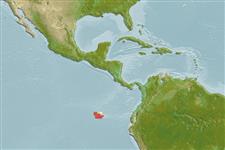>
Eupercaria/misc (Various families in series Eupercaria) >
Sparidae (Porgies)
Etymology: Archosargus: Greek, archo = anus + Latin , sargus = sea bream (Ref. 45335).
Eponymy: Louis François de Pourtalès (1824–1880) was a marine biologist born in Switzerland who spent most of his career in the USA. He presented his extensive collections to the Harvard Museum. No etymology is given, but we presume this to be the person intended. (Ref. 128868), visit book page.
More on author: Steindachner.
Environment: milieu / climate zone / गहराई सीमा / distribution range
पारिस्थितिकी
समुद्री बेनथोपिलाजिक; गहराई सीमा 3 - 30 m (Ref. 5227). Tropical
Eastern Pacific: endemic to the Galapagos Islands. This species is related only to western Atlantic forms (Ref. 9227).
आकार / वज़न / Age
परिपक्व अवधि: Lm ? range ? - ? cm
Max length : 35.6 cm TL पुल्लिंग / अलिंग; (Ref. 5590)
Frequently encountered in bay areas.
Life cycle and mating behavior
परिपक्व अवधि | पुनरुत्पत्ति | मछलीऔ का अंडे देना | अंडे | Fecundity | लार्वा
Merlen, G., 1988. A field guide to the fishes of Galapagos. Wilmot Books, London, England 60 p. (Ref. 5590)
IUCN Red List Status (Ref. 130435: Version 2025-1)
Threat to humans
Harmless
Human uses
साधन
Special reports
Download XML
इंटरनेट स्रोत
Estimates based on models
Preferred temperature (संदर्भ
123201): 23.5 - 24.6, mean 23.7 °C (based on 19 cells).
Phylogenetic diversity index (संदर्भ
82804): PD
50 = 0.6250 [Uniqueness, from 0.5 = low to 2.0 = high].
Bayesian length-weight: a=0.02089 (0.00983 - 0.04439), b=2.96 (2.78 - 3.14), in cm total length, based on LWR estimates for this (Sub)family-body shape (Ref.
93245).
Trophic level (संदर्भ
69278): 2.9 ±0.32 se; based on food items.
लौटाव (संदर्भ
120179): माध्यम, न्यूनतम जनसंख्या दुगनी होने का समय 1.4 - 4.4 वर्ष। (Preliminary K or Fecundity.).
Fishing Vulnerability (Ref.
59153): Low to moderate vulnerability (26 of 100).
🛈
